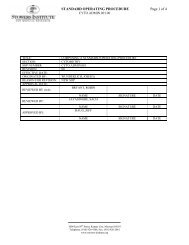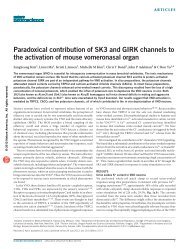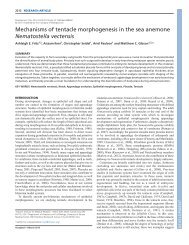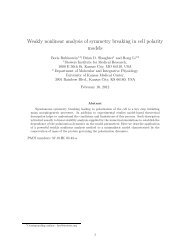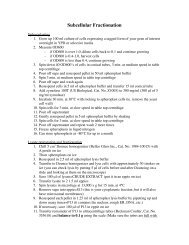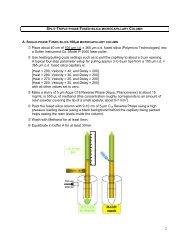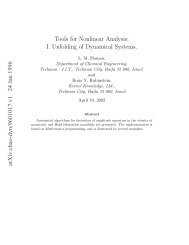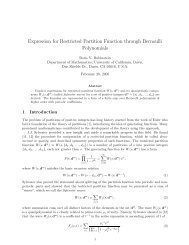Computer Tools for Bifurcation Analysis: General Approach with
Computer Tools for Bifurcation Analysis: General Approach with
Computer Tools for Bifurcation Analysis: General Approach with
You also want an ePaper? Increase the reach of your titles
YUMPU automatically turns print PDFs into web optimized ePapers that Google loves.
<strong>Computer</strong> <strong>Tools</strong> <strong>for</strong> <strong>Bifurcation</strong> <strong>Analysis</strong> 991<br />
The coefficient in Eq. (26) λ 1 = c 2, 2 (R 1 )/c 2, 1 .<br />
Formulae <strong>for</strong> calculation of coefficients c are given<br />
by the set of the replacement rules:<br />
{c[2, 1] -> Ut . U,<br />
c[2, 2][R[1]] -> Ut . f (1,1) [u, R] . U .<br />
R[1]}.<br />
The second equation is a well-known Landau equation,<br />
and the coefficient at the nonlinear term ν 0 =<br />
c 3, 2 /c 3, 1 is called the Landau coefficient. The sign<br />
of this coefficient determines the type of the bifurcation<br />
— the subcritical one <strong>with</strong> unstable limit cycle<br />
coefficient arises if the real part of the coefficient is<br />
positive, and the supercritical otherwise. The unnormalized<br />
Landau coefficient c 3,2 is produced by<br />
the function in the following <strong>for</strong>m:<br />
c[3, 2] -> -Ut . f (2,0) [u, R] . U .<br />
LinearSolve[f (1,0) [u, R], f (2,0) [u, R] .<br />
DiracConjugate[U] . U] -<br />
Ut . f (2,0) [u, R] . DiracConjugate[U] .<br />
LinearSolve[-2 I w IdentityTensor[2] +<br />
f (1,0) [u, R],<br />
f (2,0) [u, R] . U . U] / 2 +<br />
Ut . f (3,0) [u, R] . DiracConjugate[U] . U .<br />
U / 2,<br />
and can be written in the standard notation as:<br />
c 3, 2 = −U † f uu UR(f u )f uu UŨ<br />
− U † f uu ŨR(−2iwI + f u )f uu UU/2<br />
− U † f uuu UUŨ/2 , (34)<br />
where I denotes the identity matrix, which<br />
corresponds to the IdentityTensor[2] (tensor<br />
of the rank 2) generated by the function<br />
<strong>Bifurcation</strong>Theory. The R(m) denotes the resolvent<br />
matrix of the matrix m — if the matrix is<br />
regular, resolvent coincides <strong>with</strong> the inverse matrix,<br />
otherwise, resovent is constructed using the spectrum<br />
of the original matrix m. A special function<br />
Resolvent[matrix] is designed <strong>for</strong> the construction<br />
of the resolvent of a singular matrix.<br />
Finally the linear term coefficient in the Landau<br />
equation depends on parametric deviations of<br />
the first- and second-order:<br />
c 3, 3 (R 1 , R 2 )<br />
=(U † R(−iwI+f u )f uR UR 1 )(U † f uR UR 1 )/(U † U)<br />
+ U † f uR UR 2 −U † f uR R(−iwI+f u )f uR UR 1 R 1<br />
+ U † f uRR UR 1 R 1 /2 . (35)<br />
It can be easily seen that the condition R 1 = 0<br />
reduces the above general expression to linear coefficient<br />
λ 2 in (31) depending on R 2 only.<br />
The case of a monotonic bifurcation is more<br />
complicated, the resulting <strong>for</strong>mulae are more cumbersome,<br />
and we present the results of the Mathematica<br />
calculations in the standard notation. It<br />
must be noted that it has been indicated in the<br />
previous section that the first-order parametric deviation<br />
R 1 is automatically set to zero.<br />
The set of two amplitude equations describing<br />
the slow dynamics of the amplitude a now takes a<br />
<strong>for</strong>m:<br />
∂ 1 a = c 2, 2<br />
c 2, 1<br />
a 2 + c 2, 3(R 2 )<br />
c 2, 1<br />
,<br />
∂ 2 a = c 3, 2<br />
c 3,, 1<br />
a 3 + c 3, 3(R 2 )<br />
c 3, 1<br />
a + c 3, 4(R 3 )<br />
c 3, 1<br />
.<br />
(36)<br />
Now the nontrivial amplitude equation appears<br />
already at the first time scale t 1 . It contains<br />
quadratic in amplitude term <strong>with</strong> unnormalized coefficient<br />
given by:<br />
c 2, 2 = U † f uu UU/2 , (37)<br />
and corresponds to µ 0 in (12); the coefficient c 2, 3<br />
coincides <strong>with</strong> κ 2 in (12).<br />
The equation at the slower time scale gives corrections<br />
to the principal equation. Its Landau coefficient<br />
can be cast as follows:<br />
c 3, 2 =(U † R(f u )f uu UU)(U † f uu UU)/(2U † U)<br />
− U † f uu UR(f u )f uu UU/2<br />
+ U † f uuu UUU/6 . (38)<br />
The linear term coefficient is given as:<br />
c 3, 3 (R 2 )<br />
= U † f uR UR 2<br />
+(U † R(f u )f uu UU)(U † f uR UR 2 )/(U † U)<br />
− U † f uu UR(f u )f R R 2 .<br />
(39)<br />
Finally the free term in the equation coincides <strong>with</strong><br />
κ 3 in (19).




